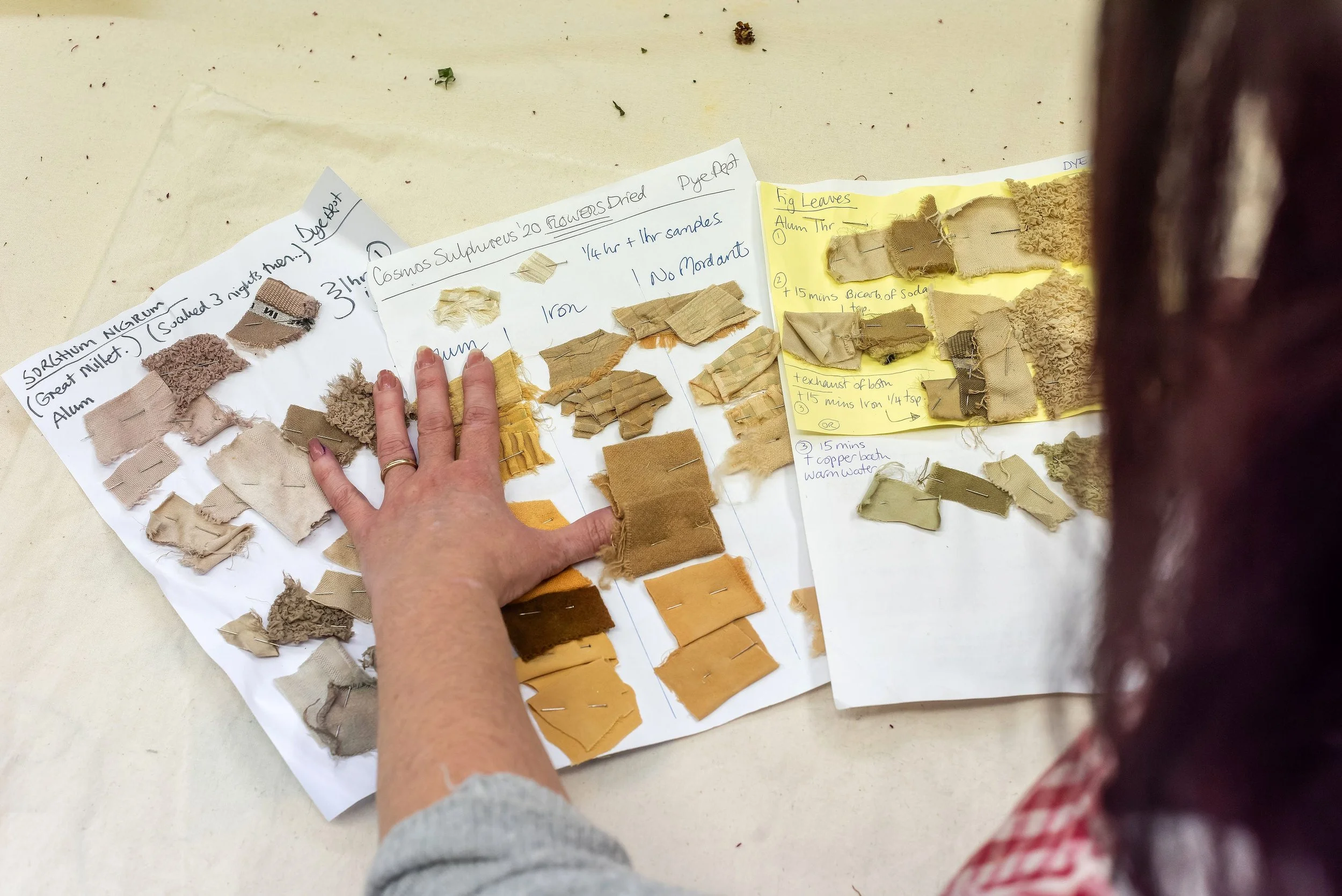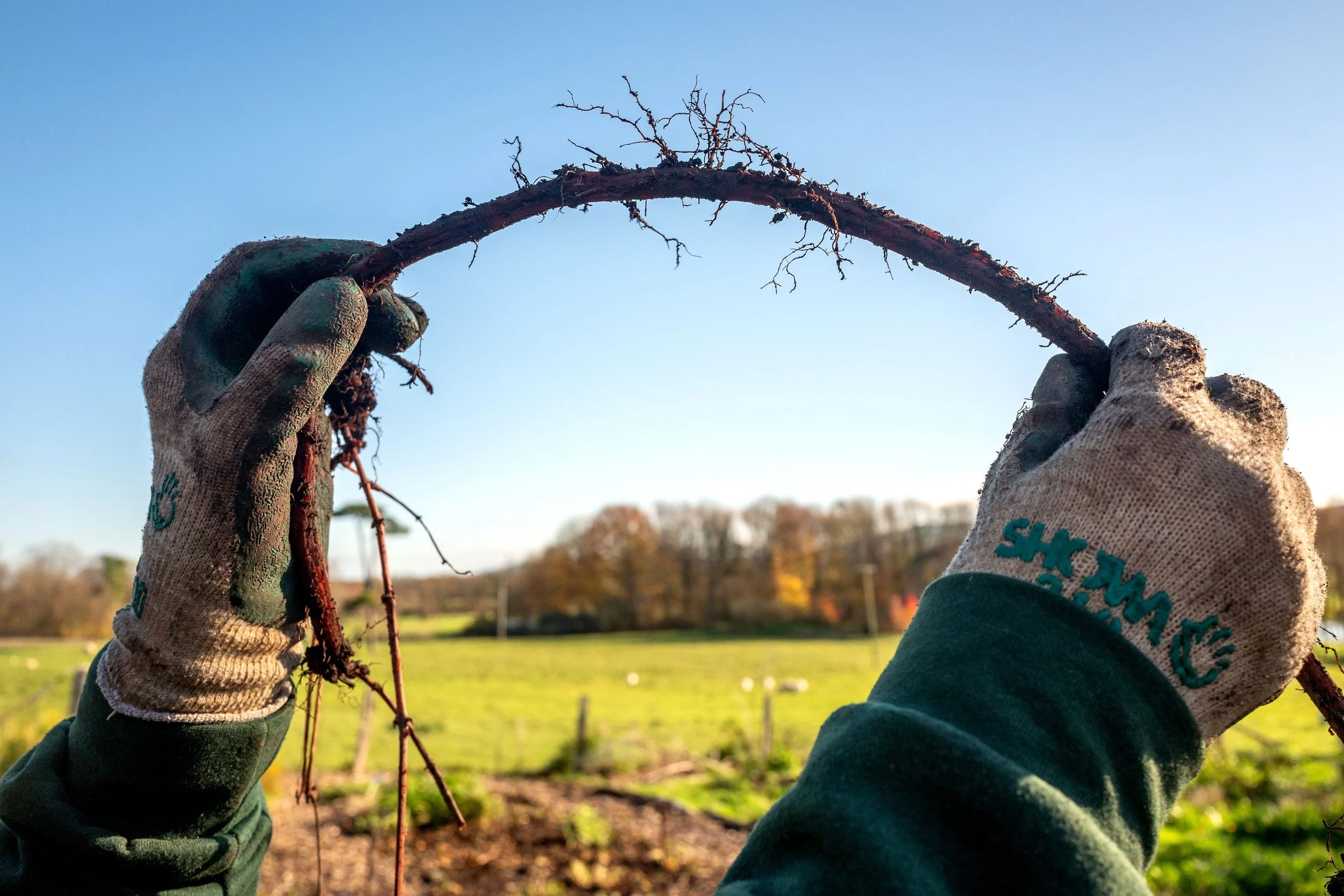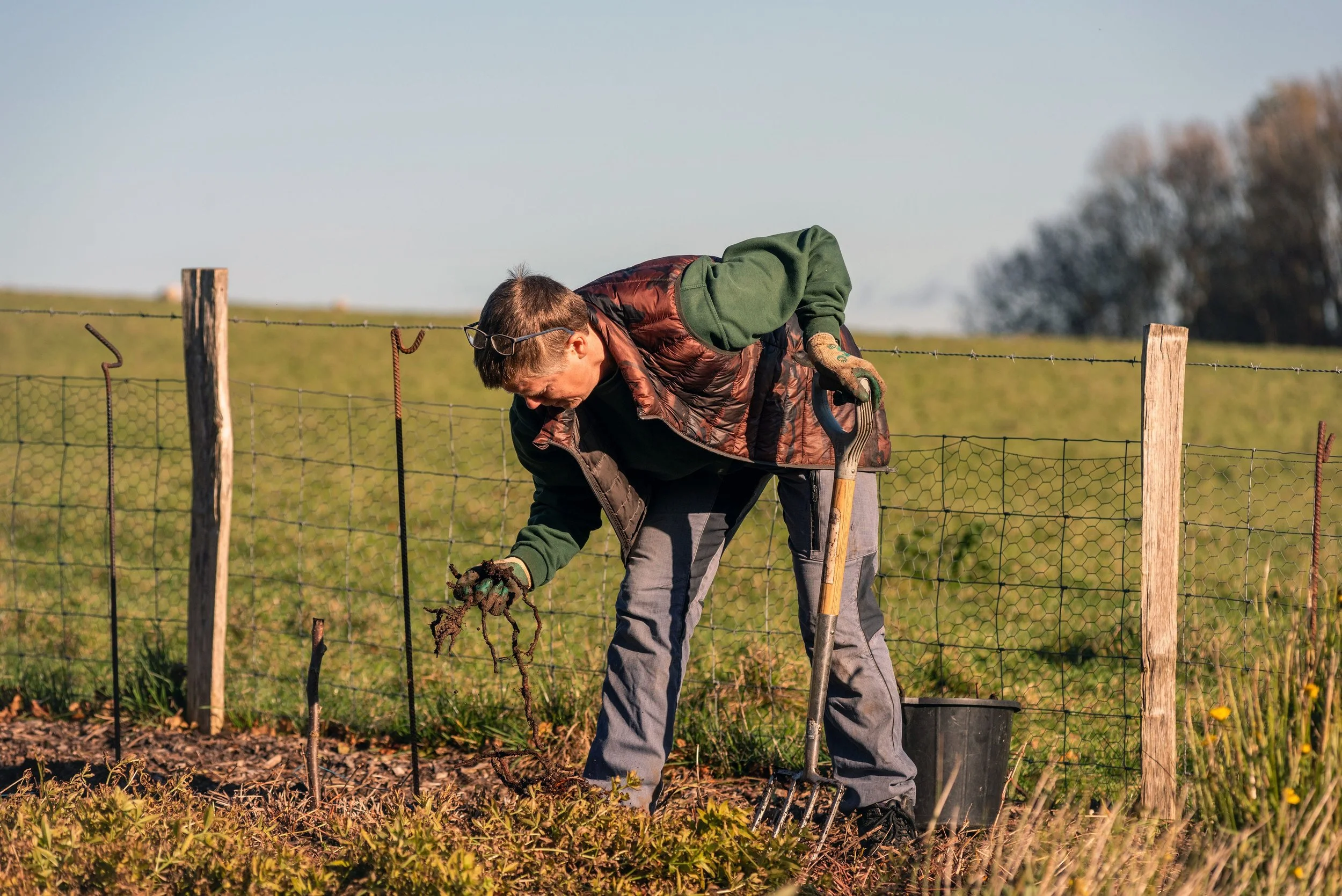Hear a behind the scenes Q&A led by Harriet, our Textiles Researcher with Jennifer Mercer (Dye Room Supervisor) and Andrea Benson (Gardener) at Glyndebourne, the world-leading Opera House.
Together, they discuss the launch of its new dye garden, sustainability ambitions at Glyndebourne and how plant-based dyes are inspiring colour in the costume department - from seed to garment.
Jennifer Mercer and Andrea Benson. Image Credit: © Glyndebourne Productions Ltd.
Jennifer Mercer in Glyndebourne Dye Room. Image Credit: © Glyndebourne Productions Ltd.
Glyndebourne is one of the world’s leading opera houses, nestled in the heart of the Sussex countryside, it is famous for its high-profile productions with leading international singers and directors. Delivering performances for an average of 150,000 visitors throughout the year across its summer festival, autumn season and year-round learning and engagement activities. All of this is surrounded by 12 acres of outstanding countryside and gardens, where visitors often drink champagne, picnic and wander the blissful grounds of the estate.
Over the past seven years, the opera house has been embracing a fresh approach to sustainability and regeneration through the launch of its natural dye garden. The garden collaborates closely with the costume department to explore innovative ways of working with colour, by drawing inspiration from the plants, land and natural environment. This creates a meaningful connection between costume design, performance and place.
Andrea harvesting Rose Madder. Image Credit: © Glyndebourne Productions Ltd.
Glyndebourne Summer. Image Credit: © Glyndebourne Productions Ltd.
Jennifer and Andrea, thank you both for agreeing to take part in this Q&A and congratulations on the launch of such a ground breaking initiative. You both played pivotal roles in developing the garden, why is this project so important to you?
A) I’ve always been fascinated by the way people interact with and use plants. Having previously worked in an educational dye garden, this felt like it was a real coming together of my interests. It feels important to not just be showing off the plants as a novelty, but to be using them and being able to say - this isn’t just ornamental, these will actually end up on stage, in an opera.
(J) It actually struck me because it is a simple idea- why wouldn’t we work in a simpler way ? It is what the environment needs us to do and it is very much available to us here at Glyndebourne.
Jennifer, I know you took a course on a biodynamic farm that focused on the cycle of life, how did that experience influence the way you’ve approached the garden?
(J) To be grateful. To always remember it is not our right to take all the flowers and plants - we are not the only beings that want or need them, but in doing so we are also helping those beings by not pouring chemical dyes into the water system and using up loads of excess water in the meantime. That it’s not just about me and my needs.
Andrea, having managed similar projects at gardens within museums, how do you ensure that you have enough plants to produce substantial colour?
(A) That was quite a steep learning curve to start off with, and to be honest, was originally based on a lot of guesswork. Ideally, I’d know exactly what harvest I can expect per plant, or per square metre of plants, and we’d know how much we would need of every colour and I could work to that. In the real world though, that rarely happens. At the start of each year, I’ll check in with Jenny, see what she has left from the previous year, and what has or hasn’t worked well. Then we work out what plants we want to grow. The amount I grow could depend on a number of factors. If the flowers can be consistently harvested through the year, I may need to grow less than something that just has one harvest. If, as in the case of the madder, it is harvested once every three years, I need to have 3 times the amount growing, so each year there is something to dig up.
Andrea harvesting Rose Madder. Image Credit: © Glyndebourne Productions Ltd.
Why is incorporating plant-based dyes and advancing sustainability such an important focus at Glyndebourne?
(J) It is a big part of Glyndebourne, - environment and sustainability-, wildlife, and the great outdoors - it is important to everyone filtering down from the top. We built a wind turbine. We are not only known for world class opera, we are also known for our pic-nics in the interval next to the lake, or taking in the rose garden, or watching the sheep in the world class gardens. It makes total sense to me that we should be doing this here. We are in the middle of nowhere in the East Sussex countryside. We also want to adhere to and uphold the ‘Green Book’ a theatre industry initiative to maintain an environmentally friendly approach to theatre work.
What is the process from plant harvest to usable dyes for fabric?
(A) I’ll harvest the plants throughout the year, as they become available. Although the plant material can be used fresh, we generally need to dry it so it will keep until the point Jenny needs it. I use our propagating unit to dry most of the flowers, and hang bundles of taller plants in our barn. Ideally the plant material needs to be somewhere warm, dark and dry, but the limits of space often meant I have bundles or trays hanging in every corner I can find. Once it’s dry, I weigh it all, store it in whatever containers we have available, and at the beginning of the new year, take everything over to Jenny.
(J) Andrea picks and dries them with the help of other gardeners sometimes, and finds a warm place in various outhouses to dry them in baskets or hanging. When they are completely dry she packs them in old containers like old wig boxes or old bird seed tubs. We clearly label it and weigh it in the winter and bring it over to the dye dept in a wheel barrow or en masse on a tractor, and I store it in a dark cool corner of my workspace until I need it .
Have you had any challenging moments, when working with mordants and modifiers to keep the costume colours from fading?
(J) I think it was just the primary time of telling everyone about it. I was happily surprised to be trusted completely with it and that nobody questioned its colour fading or longevity in a long lasting costume, as they trusted I had done my homework. But it could easily have gone the other way , but I was nervous about that originally. It really has been a department technique, where everyone has enjoyed taking it on board.
Also with costume you never really know each day what you’re going to be asked to do, so I might not have enough mordant or the right colour for a specific sock or shirt, to be done by the stage rehearsal the next day- so that has its challenges, so I’ve taken to ringing Andrea in the gardens and asking if she has any extra if I haven’t got it dried, for a specific designer on a specific day.
You are clearly dedicated to ensuring that plant-based dyes are used more consistently in the costume design, what are your concerns about synthetic dyes and the impact that these have on the environment?
(J) My concerns are huge! There’s nothing good about them really. It also has more recently struck me the water wastage too, I’ve learnt more about that over the years. Fashion productivity in particular is dreadful . We recycle a lot of costumes here from our own stores and give old costumes that are modern day to a homeless project, if we’re not doing the show again in Rep or if it’s not being sold or done on another company’s stage. But it is not just dye , its screen printing fluids, its fossil fuels, isn’t it ? It’s also when you’re conned into green washing , like when you break down a costume to age it and you think you’ll use wax to do that but find the wax (to give it the old greasy look on the cuffs for example), is actually made from petroleum so you have to source a beeswax…it’s is very sad. . All the fossil fuels heating our pots too….
Jenny Mercer in Dye Room. Image Credit: © Glyndebourne Productions Ltd.
How do you think the grounds and dye garden impact the experience for visitors at Glyndebourne and does the public seem more engaged in this regenerative approach?
(A) The gardens overall at Glyndebourne are so important, and such an important part of the experience. It makes your visit to the opera much more unique, to be able to walk in the grounds beforehand, and enjoy your interval picnic in such a beautiful surrounding. At first glance, the dye garden isn’t very obvious, as the plants are grown alongside those we use for cut flowers. But, when I’ve had the opportunity to speak to the visitors, there’s been an instant fascination with what we’re doing, and what we’re trying to achieve.
(J) It is another section of the garden for them to visit during their opera visit. It might interest the younger clientele whom we are always trying to encourage, the new lovers of opera, as they are taught more in education now. We’ve had pretty much entirely good feedback.
During my studies, I established two dye gardens, one at Nottingham Trent University and another at the Royal College of Art. Both proved to be excellent teaching tools, connecting provenance with fibre and colour. However, students were often hesitant once they realised how time-intensive the process is, from harvest to dye application. Have you encountered similar challenges?
(A) I can imagine it would be difficult to wrap your head around the timings of the process if you’re working to an academic year, especially if you’re working with the plants themselves rather than buying in ready-dried plant material. We’ve had a lot of enquiries from a number of educational institutions (schools, colleges, universities), and there seem to be more who are interested in having their own dye garden, so it appears that the interest is there. But, it is definitely a slower process, there’s no escaping that.
(J) Interestingly despite this generation having everything on demand, I also think there has been a resurgence of real craft since lock down and as I said the colleges teach it already, so a lot of our costume makers are already knowledgeable about it all.
The dye garden aligns with many of our shared values at The Great British Wool Revival, where we re-mapped a broken system from farmer to designer supporting British wool, natural dyes and best-practice. Do you think the outlook on plant-based dyes is changing and that the fashion and costume industry is becoming more engaged?
(A) I’m not in any way a fashion expert! It does seem that there is a definite interest, although maybe it’s still a bit niche. I think the timing and convenience aspect will always be an issue - there is a good reason that chemical dyes were so popular once they were introduced. But I like to think that as people become more aware of the negative effects of fast fashion, there will be (or already has been?) an increased appreciation for more ethically produced items.
(J) I can’t speak for fashion, but in costume there’s definitely a buzz around it now. The costume designers I’ve met at Glyndebourne are always interested and some have said if they’re asked back here, they’d really like to concentrate on that palette. They work 3 years in advance so it takes some warning in some ways, although other decisions get made overnight in rehearsal, sometimes days before the first night.
What are your future plans and ambitions for the dye garden into the future?
(A) I want it to become embedded in the way the gardens and costume department run, so even if Jenny and I were to leave, there would be no discussion, it would just be a done deal that it is carried on.
My ambition would be to have the whole set up really streamlined and refined, with dedicated spaces drying and storage. Ideally, I’d like a space with climate control, extraction fans, drying racks, and hanging space. I think that’s maybe a step too far at the moment though!
I also really enjoy having the opportunity to talk about what we’ve done, and to encourage other people to try it out, whether it’s costume specific, or just someone messing around in their kitchen with scraps of fabric. We’d love to do some workshops at some point, although finding the time is always a challenge. Passing on and sharing knowledge is really important to me, so whether that’s through workshops, talks, or written articles, I really want to take the opportunities to talk about what we’re doing.
(J) To hone it more, more like clockwork, better storage, availability in storage and accessibility so I’m not searching for a box somewhere to add to another box to make up the weight, in the corners of my room!
More percentage of, if not all costumes and fabrics dyed in it. The balance tilting more towards natural everyday day in the dye dept would be wonderful.
I would also like to share it and teach and show people it more and write a book to share it further afield to people who don’t know how to go about it, in opera companies across the world, We had some Scandinavian opera dyers to visit us and it was so good to share the knowledge.
Glyndebourne Dye Room. Image Credit: © Glyndebourne Productions Ltd.







